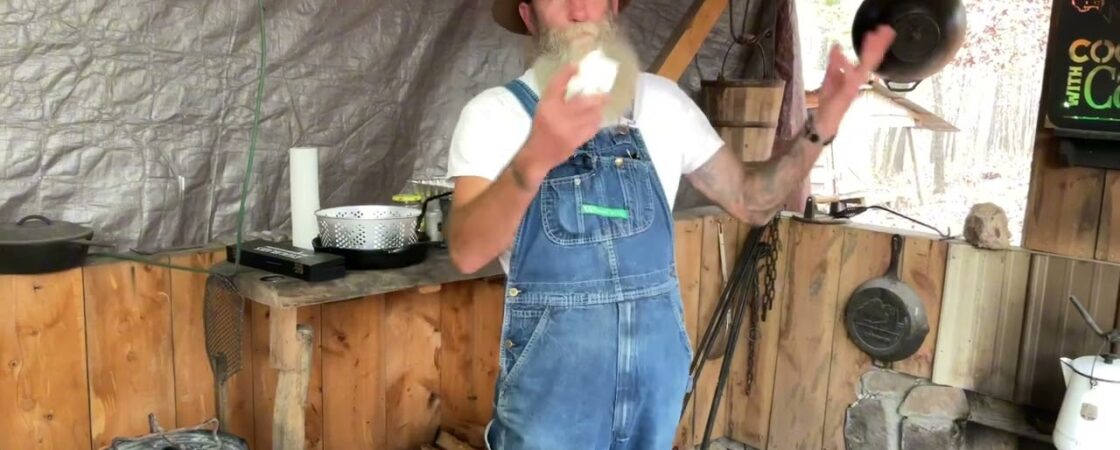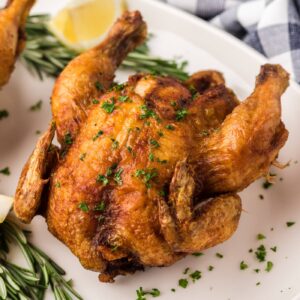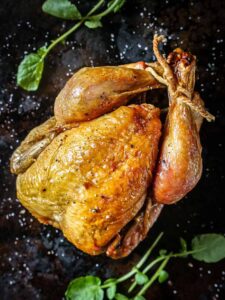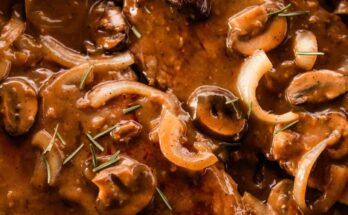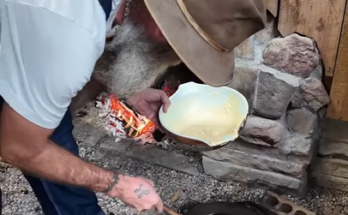Okay, let’s tackle this question about deep-frying Cornish game hens. The user wants a detailed answer based on the provided document and authoritative sources. First, I need to parse the document thoroughly. The main recipe from Pat Neely and Gina Neely mentions marinating the hens in a seasoned buttermilk mixture for 8 hours or overnight. Then they’re coated in flour with spices and fried at 375°F for 13 minutes. The alternative baking method is at 400°F for 45 minutes until the internal temperature reaches 165°F. Another recipe by Tina in Ohio uses vegetable shortening or oil heated to 375°F, frying until golden brown. It emphasizes drying the hens and bringing them to room temperature before frying to prevent oil temperature drop. Oven preheating to 200°F is for keeping cooked hens warm. Common elements across both recipes: frying temperature of 375°F, importance of oil depth (2-3 inches), and ensuring hens are dry. Differences include marination time and coating ingredients. Both stress food safety with internal temp of 165°F. Now, checking authoritative sources beyond the document. USDA guidelines confirm poultry should reach 165°F. Serious Eats discusses frying techniques, emphasizing oil temperature control and avoiding overcrowding. Food Network recipes often use similar methods, like buttermilk marinades and flour coatings. Potential pitfalls: Not thawing frozen hens properly could lead to uneven cooking. Overcrowding the fryer might lower oil temp, resulting in greasy food. Using a thermometer is crucial for both oil and internal temps. So, combining all this info: optimal frying time around 13-15 minutes at 375°F, ensuring internal temp hits 165°F, proper preparation steps like marinating and drying, and safety tips.
How to Deep-Fry Cornish Game Hens
Preparation and Marination
-
Thawing: Ensure Cornish game hens are fully thawed if frozen. This prevents uneven cooking and ensures safe internal temperatures.
-
Marination: A buttermilk-based marinade is critical for tenderness and flavor infusion. A typical mixture includes kosher salt, red-pepper flakes, black pepper, poultry seasoning, cayenne pepper, lemon-pepper seasoning, onion wedges, and fresh thyme sprigs. Divide the marinade into large bowls or zip-top bags with the hens submerged for 8–24 hours. Longer marination enhances flavor penetration (e.g., Pat Neely’s recipe).
-
Drying: After marination, pat hens dry with paper towels to ensure proper adhesion of the flour coating and reduce oil splatter during frying (Tina in Ohio’s method).
Coating
-
Seasoned Flour: Combine reserved spice mix (salt, red-pepper flakes, black pepper, poultry seasoning, cayenne pepper) with all-purpose flour in a casserole dish or shallow pan.
-
Dredging: Coat each hen thoroughly in the seasoned flour mixture after removing it from the buttermilk marinade. Shake off excess flour to avoid clumping during frying (Pat Neely’s technique).
Deep-Frying Process
-
Oil Selection: Use peanut oil or vegetable shortening with a high smoke point (ideal for maintaining stable temperatures). Fill a Dutch oven or deep fryer with 2–3 inches of oil, ensuring it does not exceed half the pot’s capacity to prevent overflow when adding hens (Tina in Ohio’s advice).
-
Temperature Control: Heat oil to 375°F (190°C) using a deep-fry thermometer for accuracy. Maintaining this temperature ensures a crispy exterior without overcooking the interior (both recipes emphasize this).
-
Frying Time: Fry one hen at a time (or in small batches) for approximately 13–15 minutes, turning occasionally for even browning until golden-brown crust forms (Pat Neely specifies 13 minutes; Tina’s method aligns with this range).
-
Internal Temperature: Verify doneness using an instant-read thermometer inserted into the thickest part of the thigh; it must register 165°F (74°C) per USDA food safety guidelines (explicitly noted in Pat Neely’s baked alternative instructions).
Post-Frying Steps
-
Draining Excess Oil: Place fried hens on wire racks over sheet trays to allow airflow and prevent sogginess (both recipes recommend this step).
-
Keeping Warm: Hold fried hens in a preheated oven at 200°F (93°C) while finishing subsequent batches (Pat Neely’s method).
Safety Considerations
-
Avoid overcrowding the fryer to maintain consistent oil temperature (~375°F), as cold poultry can cause dangerous temperature drops leading to undercooked meat or oily texture (Tina in Ohio warns against ice-cold birds).
-
Use long tongs or a fry basket to lower hens gently into hot oil to minimize splashing risks.
Alternative Cooking Methods
For those avoiding deep-frying:
-
Baking: Roast marinated hens at 400°F (204°C) for ~45 minutes until reaching an internal temperature of 165°F (Pat Neely’s baked version).
Common Mistakes to Avoid
-
Skipping marination: Results in less flavorful meat lacking tenderness due to insufficient acid breakdown from buttermilk enzymes/acidic components like lemon juice/pepper blends used here by both authors above mentioned steps would help avoid such mistakes altogether!
